Optimising Old Content: How to get more Organic Traffic to your site
- Home
- Optimising Old Content: How to get more Organic Traffic to your site
Refreshing and republishing old content is one the most effective and efficient ways of improving the organic traffic to your site.
Historical Optimisation, as it’s sometimes known, is the process of taking your existing content (blog posts, landing pages and so on) and giving it a fresh lease of life – and by doing that, improving the impact and appeal of your website.
Search engines like Google love content that’s useful to humans searching for answers to their problems. They also favour resources that have been around long enough to build up popularity and authority on a topic, and those that are tended to regularly.
In other words, by updating your content to keep it fresh, relevant and useful it will rank higher in search engine results and drive more traffic to your site.
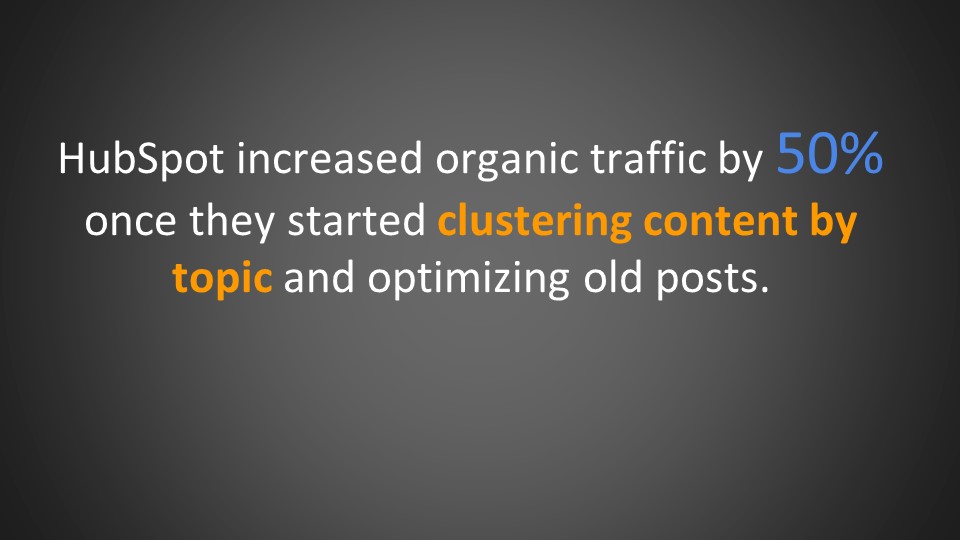
When HubSpot embarked on a programme of historical optimisation they saw organic search views of their updated blog posts go up by 106% on average. Their monthly leads generated by these posts also more than doubled.
So you can see the enormous impact you can have – without even having to write new material!
In this article, we’ll take you through how to optimise your old content to get more organic traffic to your site. It’s based on a 3-step process:
- Analyse and identity which of your old content is worth updating (and which is worth deleting). Selecting the right keywords to rank for your optimisation will have the biggest effect.
- Update old content for quality and readability, on-page and technical SEO.
- Distribution and link building after you’ve republished your pages. Getting your content to more people and building links from other reputable sites will help increase the authority of your domain and push your content up results pages.
Definition of Historical Optimisation
Firstly, when we talk about ‘old’ or ‘historical’ content we’re not necessarily talking about ancient texts. The content worth updating and republishing might have been written as recently as 6 months ago. Or it could be 5 years old. Anything that has been online for enough time to rank on search engines and for people to find.
Some details or statistics may need reviewing after a while to keep up with the fast pace of the digital world. There may also be tweaks in, say, meta-descriptions, keywords or alt tags that can be refined through analysing a decent period.
E.A.T." Content
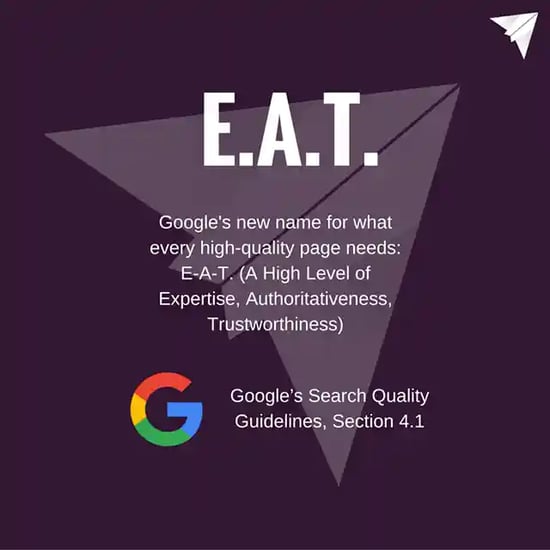
Image Source: https://www.lokalyze.com/how-to-create-financial-content-that-google-will-love/ymyl-eat/
One popular way of thinking about content is the EAT acronym, which stands for Expertise, Authority and Trust. This neatly summarises how to rank highly on search engines. If your content shows that:
-
you know what you’re talking about;
-
other reputable sites also think so by linking to you; and
-
those searching for the answer to a problem find your content useful,
then you have everything it takes to rank well and attract organic traffic.
This is a useful benchmark for all your site content, both new and old. But with the following steps you can make sure that everything under your domain is ticking the right boxes.
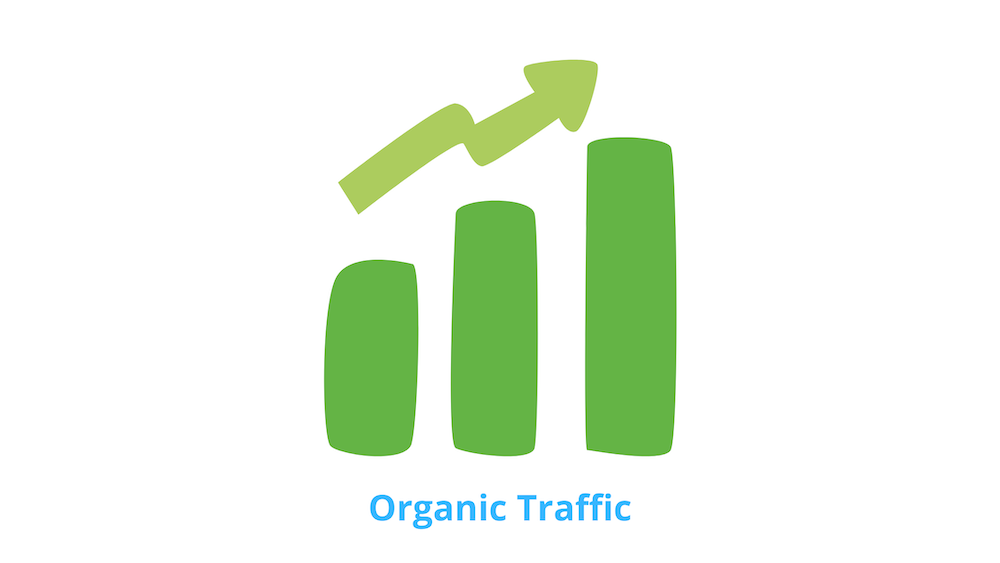
STEP 1. Analyse your old content and identify what to improve
The idea of inbound is to attract visitors to your website by posting expert advice about your business’s niche. So if your business is engaging in content marketing or digital marketing of any kind it’s very likely that after some time you’ll have produced quite a lot of content.
Hopefully, this is all good quality material, consistently drawing lots of traffic. But inevitably we all have pieces that either start well and then dip or that don’t ever quite get the viewers we hoped for a particular search query.
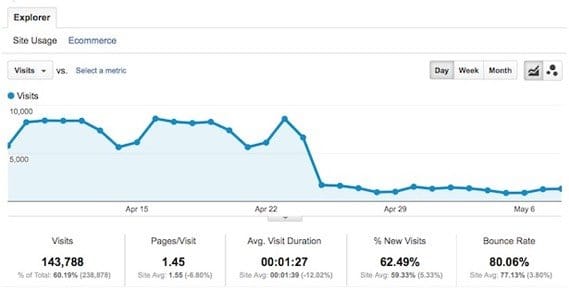
Image Source: https://growtraffic.com/blog/2016/05/drop-traffic-google-analytics
There’s always room for improvement – especially as content gets older and risks becoming less relevant. Google makes hundreds of changes to its algorithm every year, so a post can rank well for a while, and then suddenly drop off due to a core update.
Furthermore, it’s well known that Google likes fresh content. Search engines exist to provide useful answers to what people want. Think about when you’re searching online: are you more likely to click on a link that was published last week or four years ago?
Remember that the first page of Google search results is where about 75% of clicks occur. To increase traffic your content needs to rank on the first page, and to take a share of 68% of all clicks, ideally, it must be in the top five search results. The number one spot receives about 37.1% of all clicks.
So how do you find out which content can be pushed up the search engine results pages (SERPs) for which keywords – and most importantly, how?
Do a Content Audit
The first thing to do is to go through all your content and identify which pieces need what kind of action.

It’s worth splitting your old content into three different criteria and setting appropriate thresholds for each group:
-
Content that’s so old, outdated or low in traffic that it can be deleted
-
Content to leave as it is
-
Content to update – if it has a good level of traffic but can be improved, or the relevancy or quality, in general, could be better but is not so bad it should be thrown away
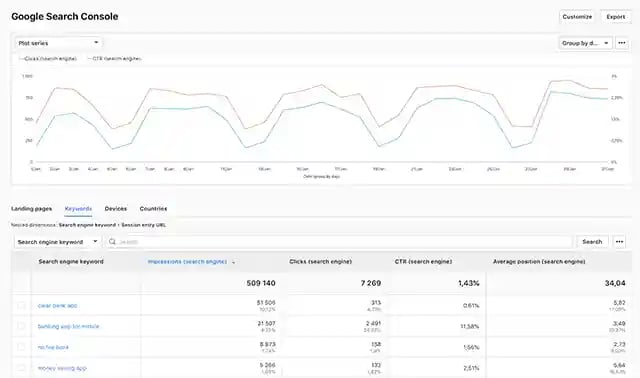
Image Source: https://help.piwik.pro/support/integrations/google-search-console-integration/
Using a tool like Google Search Console, Neil Patel's UberSuggest or Ahrefs Site Explorer you can see which pages of your website are underperforming. This software will tell you things like traffic numbers, where your content ranks for certain keywords, clickthrough rates (CTR), and it’ll give you a general good sense of the content’s health.
WHICH CONTENT TO DELETE
Start with low-quality pages, referred to by Brian Dean of Backlinko as “Zombie Content”. These can do more harm than good to your website. Delete outdated blog posts, landing pages, offers and anything that’s no longer relevant.
A post that mentions technology or social platforms that no longer exist, or one that hasn’t had significant views for years are obvious examples of content that can be deleted.
You can remove these pages entirely, add a ‘no index’ tag to them, or set up a 301 redirect to more relevant material on similar topics.
However you perform the cull, this is a simple, crucial and effective step towards increasing your domain authority. Old, irrelevant content is like carrying dead weight – the more you offload, the better your website.
WHICH CONTENT TO LEAVE AS IS
If your analysis shows a page ranks at 2 or 3 on average and is getting consistently good traffic, then that’s a good sign that it’s performing very well. Making changes to this kind of content is more likely to harm than help. Let good content do its job.
Other pages that shouldn’t be tampered with are pages under 6 months old as these won’t have had enough exposure yet to give you an accurate idea of their quality.
WHICH CONTENT TO UPDATE
Identifying which pages can be materially improved is the main aim of the historical optimisation process. This category can consist of everything that isn’t in either of the other two.
The best pieces for improvement will show indications like high traffic but low conversion or vice versa. Similarly, posts that already rank in the top 10 for meaningful keywords but not the top 3 might be able to inch further up against their nearest competitors.
Tracking tools like Ahrefs or Google Search Console will be able to tell you which are your most viewed pages. They’ll also indicate how your pages are performing against the most meaningful keywords.
Make sure your keywords have a significant level of overall traffic to rank for, and that competition isn’t too fierce. Identifying the best keywords is an important step which we'll come onto.
Judging the thresholds for these criteria is something you’ll have to decide. Set them too high and you’ll have a tough task making effective improvements. Too low and there may be too much material to work on. Find the right balance through the analytics data to make the biggest impact.
COMBINING CONTENT
It may be that some of your content is a little thin but has some strong elements that are worth retaining. This is where you can consider combining pieces of content on the same topic rather than deleting or just leaving them as they are.
If your website has pages that are based around the same keywords, see if you can amalgamate them into one long-form authority piece on the topic.
You should now have a list of pages that are ripe for optimisation. The last stage in the analysis process is identifying how to improve them. What elements of the page will make the most difference? On-page SEO tactics? Readability? Aligning with searcher intent?
We’ll cover these criteria in more detail in Step 2, but first, a word about keywords.
KEYWORD RESEARCH
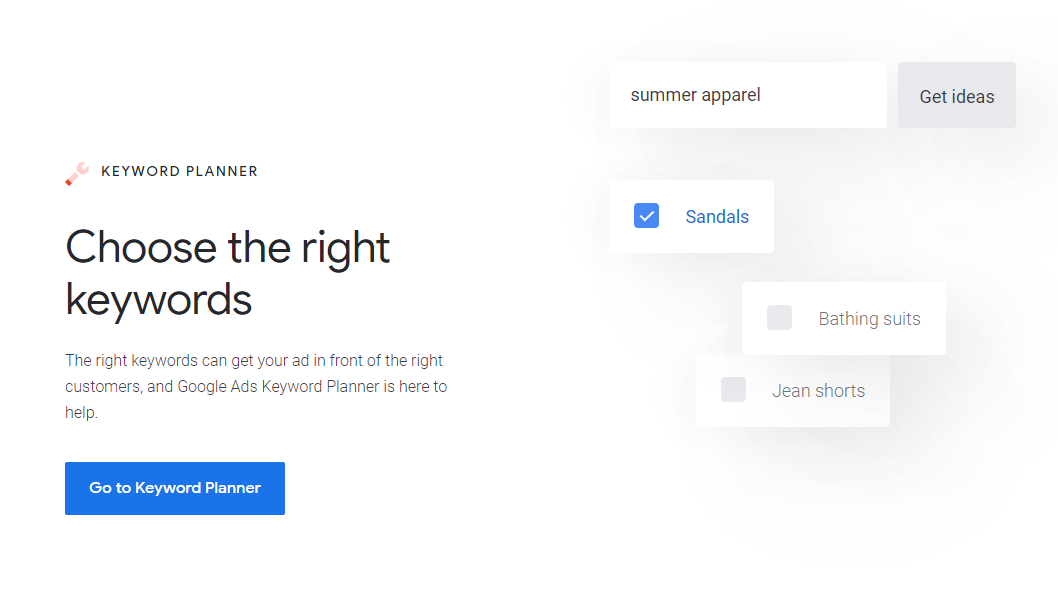
Before we start making changes, we need to investigate what keywords to rank for. Keywords are the foundation of organic search. If your site can appear high up on the SERP for a popular keyword then views will inevitably grow. Keywords are directly linked with user intent – i.e. patterns of behaviour of people searching for a given topic.
Look for keywords with relatively low organic search difficulty rating and reasonably high search volume.
This means there’s a decent chance of ranking for the keyword if your content is good and enough people searching for the query to make targeting it worthwhile.
As mentioned, software exists that can help with this – and a good marketing agency may have professional-level access to tools like Ahrefs Keyword Explorer, SEM Rush, Moz or KW Finder. Or even content professional onboarding tools that HubSpot provides.
However, there are also simple methods you can employ to get a good idea of popular keywords for a particular topic.
Say you’re looking to optimise an old blog post you wrote on the latest camping equipment for your outdoor supplies business (maybe since its publication four years ago new models of tent or camping stove are the market and warrant mentioning).
Your first port of call as a provider of authoritative content should be the same as the viewers of your content: Google.
You may have noticed before that Google has helpful additional search tips around its SERP pages that indicate popular searches related to your topic.
Google Autocomplete: when typing in ‘camping stove’ in the search bar, it will suggest additional words, like ‘gas’, ‘grill’, or a range of local stores where you can buy one. If any of these are relevant to your article, take the whole phrase as a keyword to insert into your article.
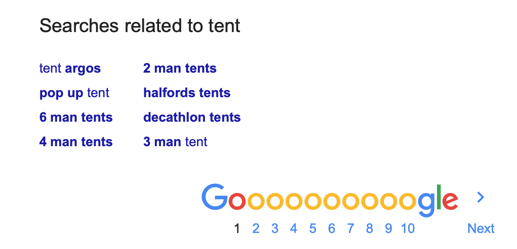
People Also Ask & Related Search: these are extra elements Google inserts in the middle and end of SERPs to help surfers find similar topics. They’re another insight into the searching behaviours of Google users, and also worth including in your content.
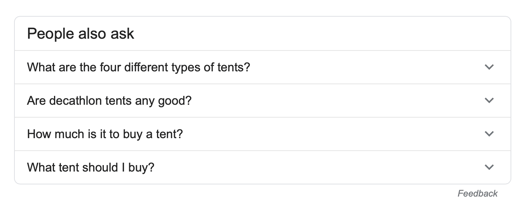 Armed with current popular keywords and a better understanding of searcher intent for your topic you are now ready to optimise.
Armed with current popular keywords and a better understanding of searcher intent for your topic you are now ready to optimise.
STEP 2. Updating your content for optimisation
Now you’ve narrowed down your selection of old content pages that will benefit from optimisation, it’s time to make those improvements.
The different types of changes to make can be grouped as follows:
-
On-Page SEO – optimisation techniques that can be performed on the page itself that will affect how your content ranks on search engines.
-
Technical SEO – optimisation techniques that have more to do with structural site link issues.
-
Copy and design elements – things like the quality of the writing, readability and layout of the page, visual appeal, etc. which make people want to stay on your page and consume your content.
These categories will overlap. For instance, writing readable, relevant sentences should include your chosen keywords in appropriate places, hitting on-page SEO and quality copy elements at the same time.
It’s also worth noting that often an old piece of content can benefit from two or even all three of these optimisation areas.
ON-PAGE SEO
SEO or Search Engine Optimisation is a methodology designed to make your website fit what Google, Bing, Yahoo and others look for when ranking pages.
While search engine algorithms change over time and their full details aren’t publicly known, certain factors have been confirmed by Google or through marketers’ research that we know can improve a page’s rankings.

Image Source: https://rankz.co/blog/google-october-2018-changes-google-algorithm-updates/
You probably had on-page SEO principles in mind when first creating your content. It’s good practice that’s often built into CMS software like HubSpot or WordPress.
Nonetheless, when revisiting old content it’s worth going through an SEO checklist and comparing on-page tactics with your analysis of your content’s performance to date.
On-page SEO elements to increase your organic search rankings include:
-
Short, Precise URLs – each word separated by a hyphen, keep it concise and include the primary keyword if possible.
-
Engaging Title Tag and Meta-Description – these are the bits of text that appear in search results. Are they the right length? Do they contain the keywords that your analytics suggested you can rank for? Will they grab attention and encourage people to click?
-
Heading Tags – make sure that every heading has an appropriate tag (i.e. H1, H2, H3, etc.) This tells Google what phrases and topics are most important and helps it understand the structure of your content.
-
Internal and External Links – linking to more of your content encourages readers to stay on your website for longer, digesting more of your brilliant resources. External links to relevant material should be used more sparingly, but demonstrate that you know about helpful resources, building trust.
-
Optimised Images – a big part of the user experience of your web page is the use of images. Can large images be reduced in size (while remaining clear) to load quickly? Check images for keyword-rich alt text and titles.
These are all relatively quick and easy tactics that can be applied to the pages themselves. Combined, they alone can have a great impact on your ranking and organic traffic. Consider a free tool like INK to further aid on-page optimisation fixes.

TECHNICAL SEO
This overlaps with on-page SEO but it refers more to issues with page links, and source code or external issues.
When it comes to historical content, such issues are more likely to arise the longer it is since an update. This is because links can become outdated, site structures can evolve and changes to search engine algorithms can alter the relevance or ranking of a webpage.
So once more it’s advisable to crawl your page with SEO software to give you detailed analytics of technical issues and how to fix them. Raven, SEMRush or Ahrefs’ audit tools are all good options. Also, try free specific tools like Broken Link Checker.
Here are some technical SEO issue examples:
-
Page Loading Speed – faster loading is known to be a ranking factor for Google. Put the URL into Google Page Speed Insights for tips to reduce loading times.
-
Mobile Responsive – an increasingly large proportion of web surfing is done through smartphones. CMS website builders often allow you to specifically edit the mobile version of your site. Make sure the mobile user experience is just as good as the desktop, with images automatically resizing, appropriate layout, etc.
-
Robots.txt – these tags tell search engine bots which parts of a site to crawl or not crawl. Over time parts of a website that were ‘hidden’ may need to become visible.
-
Broken Links – if you have a link to an external page that no longer exists or has significantly changed, that may frustrate a user who has clicked on it. Check links and remove or replace any that are broken.
-
Redirect Obsolete Pages – make sure any internal links to old pages that you removed earlier in the process have 301 redirects applied where appropriate. This ensures that internal links to them still go to other relevant pages. Link equity built up over time is also maintained.
By checking and updating these elements of SEO periodically you’ll increase the quality of your content as well as increase your chances of ranking.
COPY AND WEB DESIGN
This final element of optimising your old content applies to the actual text, images, multimedia and layout of your pages.
While good SEO principles can go part of the way to increasing organic clicks from search engine results, once viewers come to your site they need to enjoy a pleasant and appealing user experience.
There are several ways to optimise the way your content is consumed:
-
Dwell Time – similar to loading speed, this relates to how long readers stay on your page. If they bounce straight back to the results pages after a few seconds you need to make your offering more enticing. Moving content higher up the page so they don’t have to scroll, reducing big gaps at the start and writing a brilliant introduction are all good practices. The first thing they see should make them want to stay.
-
Writing Quality – not everyone is a professional copywriter, but your content needs to at least be in good, readable English. This doesn’t mean it has to be formal – a conversational style is often more appealing. But correct spelling, punctuation and grammar show you know and care about your topic, and make content more user-friendly. Simple mistakes are often missed on the first publication and more noticeable on a later reading.
-
Visuals – research has shown that readers are more engaged by blog posts with images. If your article has long blocks of solid text, add a relevant photo or graph, embed a video or GIF. Also, consider upgrading outdated infographics.
- Type of article – is yours a "Beginners' Guide to..." article when the top 3 competitors' articles are all "Top 10" list articles? If you're being outranked for a meaningful keyword by posts that have a different format to yours, consider rewriting the article and title to reflect the most popular stance.
-
Layout and Structure – are all the headings serving a purpose? Is there a logical sequence to each section of your page? Is the page as a whole well designed with plenty of whitespace, or is it cluttered with too many large images or uneven text sizes? Look at competitors' similar articles for similar headings. If your article is missing a common topic, add your version.
-
Answer the Query – having researched keywords and user intent, focus on providing expert advice. Adding a new section with an ‘Update’ heading, for example, shows readers you are familiar with the latest trends and data. Google rewards freshness.
Consider hiring a freelancer to edit your existing copy or even rewrite some sections. Add new insights wherever possible. Give searchers a good reason to click on your page. Adding brackets and the year in the title can indicate up-to-date content.
Lastly, check competitors’ websites in the search results for your keywords. Look at the ads at the top of SERPs first. Then if you’re ranking at number 7, what are the top 6 listings doing that you’re not? If they all have similar titles, such as ‘How to...’ or ‘The Ultimate Guide to...’ then consider matching them.
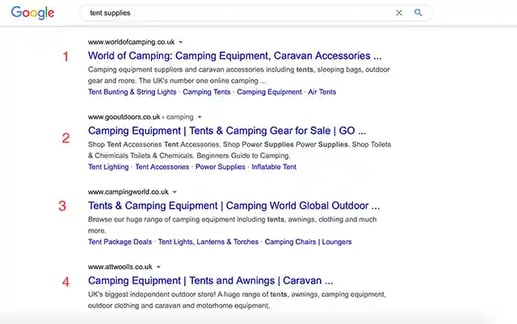
Many marketers talk about the ‘skyscraper technique’: finding the best content out there on a given topic and producing something even better. Analyse your competition, see what they’re doing to rank highly and top it.
Now that you’ve updated your chosen pieces of content, it’s time for the final step in the historical optimisation process.
STEP 3. Republishing and Distribution Strategy
All the above tactics will give your content a fresh lease of life. Your organic search traffic should show a powerful increase if you’ve done a careful audit and enacted significant improvements to your SEO and the quality of your pages.
REPUBLISHING
A couple of final tips when updating your content:
-
Update the Publish Date - signal to search engines and readers that you’re tending to your content by republishing under the current date.
-
Submit for Reindexing – you can request that Google reindex your URL for fresh content via Google Search Console, or just leave it to be recrawled automatically in a couple of weeks.
LINK BUILDING
One very important component in building authority is having a good number of quality backlinks. In the same way that you link to external resources in your pages, when a third-party site links to your content it shows Google and readers that they have trust in your expertise.
With authority being such a huge ranking factor, you should always be aiming to increase your number of backlinks – in new and old resources.
This is another area where analysing your closest competitors can be useful. Ahrefs Content Explorer, for instance, can tell you which sites are linking to the pages at the top spots.
These linkers are people worth contacting – even before you update your content. Build expectations and get help to build your backlink profile.
Prospecting or outreach to high authority domains can lift your ranking if they like and link to your content. Consider asking influencers in your industry to guest blog for you on the back of your updated content.
It's also worth remembering that you may already have some important backlinks. When updating content you need to be sure to keep the text attracting these backlinks to prevent damaging your domain rating. Ahrefs Site Explorer allows you to see what text external sites are linking to, so look at your backlinks report and keep the most relevant text when republishing.
CONTENT DISTRIBUTION STRATEGY
You’ve now done the difficult bit – removing content that no longer works and optimising pages with the most potential. To maximise the impact on your organic traffic this is an opportunity to promote your refreshed pages to as wide an audience as possible.
As you should be doing whenever you publish brand new content, use social media platforms to spread the word. If you’ve done a good job on your historical optimisation your pages should be more readable, more authoritative, and have more utility for your target audience – and therefore they’ll be worth shouting about (again).

Organic traffic comes from clicks when you appear in search queries. However, the more people that know about your high-quality content through social channels, the more views and shares you’ll accrue, and therefore your organic ranking will also benefit.
The best way to promote your optimised content is with a multi-channel distribution strategy. We talk about this in detail here but let’s summarise the basic steps:
-
Step 1: Produce a piece of long-form content
This is your newly updated article. Ideally, an in-depth piece of authoritative material covering a narrowly focused topic in your business niche. The more it’s filled with useful, expert advice (EAT) the more you’ll have to draw on for the remaining steps.
-
Step 2: Create several pieces of ‘microcontent’ from the original page
Using quotes, images, statistics, and anything eye-grabbing and worth highlighting, design short-form pieces of content tailored specifically to each social media platform. To use the earlier camping example, Instagram use square images, so a square photo of a top-of-the-range tent with a quote about its unique specifications would be appropriate.
Effective examples of good micro-content include:
-
-
GIFs
-
Memes
-
Short videos
-
Podcasts featuring you reading your content or interviewing somebody else about the topic
-
Remixes and mashups
-
-
Step 3: Distribute micro-content
As soon as your updated content goes live, release all of your micro-content across your social media channels. The aim is to publish everything for maximum impact. You’re aiming to reach the highest possible number of viewers at once to achieve a kind of snowball effect of increasing views.
-
Step 4: Listen to feedback from your followers
Keep a close eye on comments, likes, shares and retweets. If you encourage them, your audience will tell you what’s working and what they enjoy about your material.
-
Step 5: Repeat the process with this feedback material
Put positive comments into new quotes and stories, serving another wave of social media channel distribution. If your most engaging followers and early adopters show their appreciation you can amplify their feedback to entice new viewers.
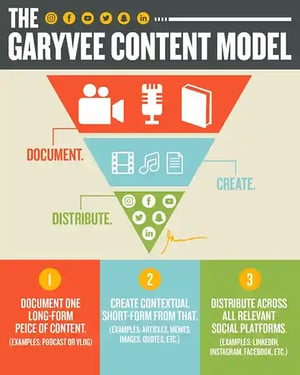
This process is based on Gary Vaynerchuk’s inverted pyramid model that he demonstrated in his 2018 slide deck. He turned one piece of long-form content into 35 million views.
Conclusion
Optimising old content is an efficient way of attracting more organic traffic. Instead of investing the time and effort required to start a brand new blog post or landing page from scratch, you can use your existing assets to boost your views.
To summarise, there are several big advantages besides time savings:
- You maintain the link equity and authority your previous work has already built up.
- The process ensures that your content library is up to date and tidy, and there’s no outdated low-quality material bringing down your site’s rankings.
- It reminds you to work on your link-building by prospecting and outreach
- It keeps you updated with the latest trends in your industry
- You sharpen your writing and SEO skills
- A regular close eye on your site’s performance analytics is essential for any successful digital marketing strategy
- The more search engines and users visit your site and get to know you as a trustworthy resource, the higher your clickthrough rate will be, and the more leads you’ll have to grow your business.
According to HubSpot the primary goals of historical optimisation updates are accuracy, freshness and comprehensiveness. The closer you come to achieving these objectives, the more organic traffic you’ll win.
If you want further guidance on optimising your old content, a good digital marketing agency can help you put a plan in place. Why not give Whitehat a call to discuss your next steps?



